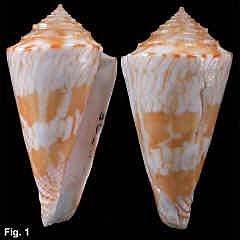|
|
|
|
Conus howelli Iredale, 1929 Description: Shell light to medium in weight; tall, slender, with concave or straight sides. Body whorl varies in sculpture from smooth, except for a few spiral ribs anteriorly, to spirally ribbed over its whole length; about 50 ribs in adult shells, less in juveniles; irregular axial growth lines usually present. Shoulder sharply angled. Spire medium to high, stepped, sometimes nodulose on early whorls. Spire whorls concave, not spirally ribbed, smooth except for curved axial growth striae; margined with keeled edge. Aperture constant width; outer lip straight. Colour variable; at one extreme, with white, wavy, ribbon-like axial stripes, closely set, with two or three spiral bands of yellow-brown; at the other extreme, a background of yellow-brown with irregular white patches. Interior white. Size: Up to 49 mm in length. Distribution: Eastern Australia, from southern Queensland to Eden, NSW, in 33-274 metres; also Lord Howe Is, northern New Zealand, and sea mounts between New Zealand and Lord Howe Is, in 64-228 metres. Habitat: Deep water, as above. Rare. Comparison: The tall, concave body whorl shape of this species resembles C. sculletti and C. wallangra, but the high stepped spire and distinctive colour pattern distinguish it from both these species. The same features differentiate it form C. minnamurra, with which those specimens with ribbing on the entire body whorl show some similarity. Remarks: Although well known from eastern Australia, the presence of this species in the north of New Zealand has only recently been described by Marshall (1981), who provides a detailed account of its distribution and comparison with related species. Fig. 1 Off Stanwell Park, NSW (C.115350)
|
